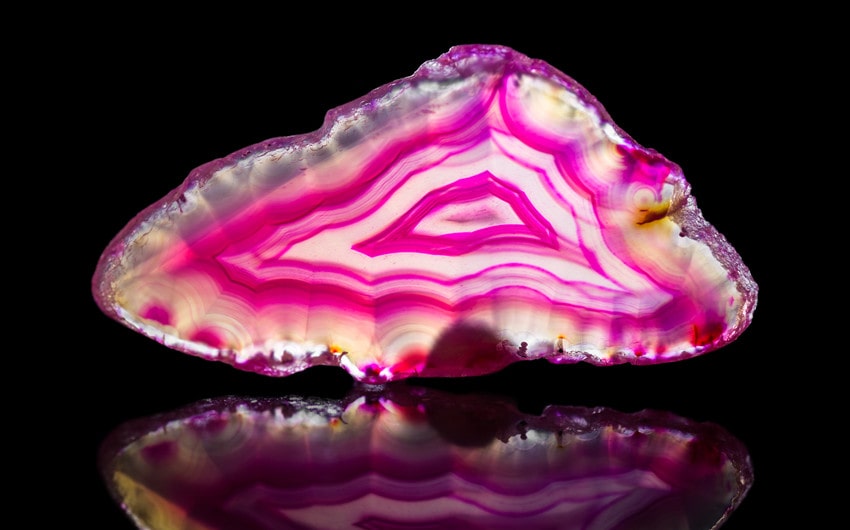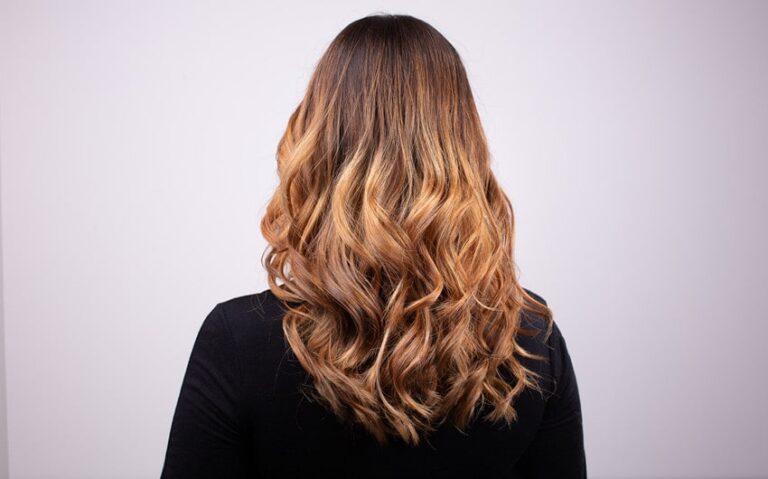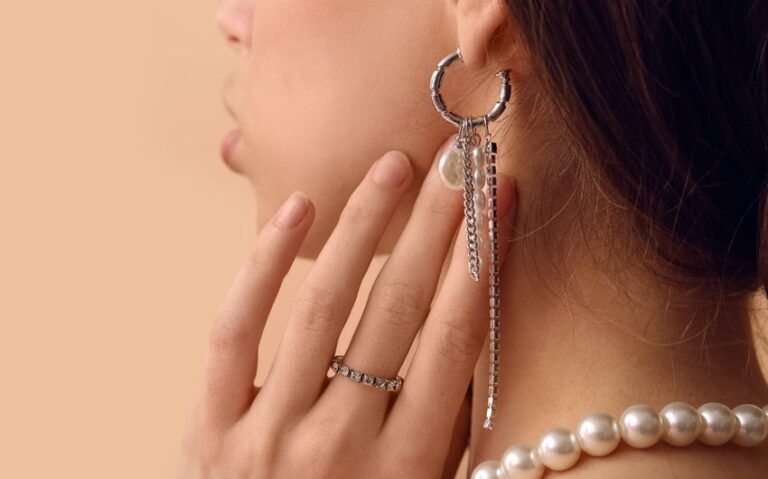What Makes Pink Agate Special? Learn Its Meaning and Uses
There’s something truly captivating about pink agate. Whether you’re drawn to its soft, calming color or its unique patterns, this beautiful gemstone has a way of catching your eye and lifting your spirits. Loved for both its aesthetic appeal and its believed healing properties, pink agate is a favorite among jewelry makers, collectors, and those seeking balance in their lives. From its soothing energy to its natural beauty, pink agate offers something special for everyone. Let’s explore the origins, uses, and significance of this fascinating stone.
What is Pink Agate?
Pink agate is a beautiful and calming variety of the agate family, which is a type of chalcedony, a mineral belonging to the quartz family. Like all agates, pink agate is distinguished by its unique banding patterns and layers, which are formed over thousands of years through the slow deposition of minerals in rock cavities. The result is a stunning, layered gemstone that ranges in color from soft blush pinks to deeper, more vibrant pink tones.
Agates are known for their grounding properties, and pink agate is no exception. It is often associated with emotional healing, love, and compassion, making it a favorite among those who seek balance and peace in their lives. The pink hues of the stone are thought to resonate with the heart chakra, promoting love, kindness, and emotional strength.
Pink agate can form naturally, but it is also common to find dyed agate stones that have been enhanced to bring out even more vibrant pink tones. Natural pink agate is typically softer in hue, whereas dyed versions can range from pastel pinks to bright, bold pink shades. Whether natural or dyed, pink agate is prized for its beauty, versatility, and metaphysical properties.
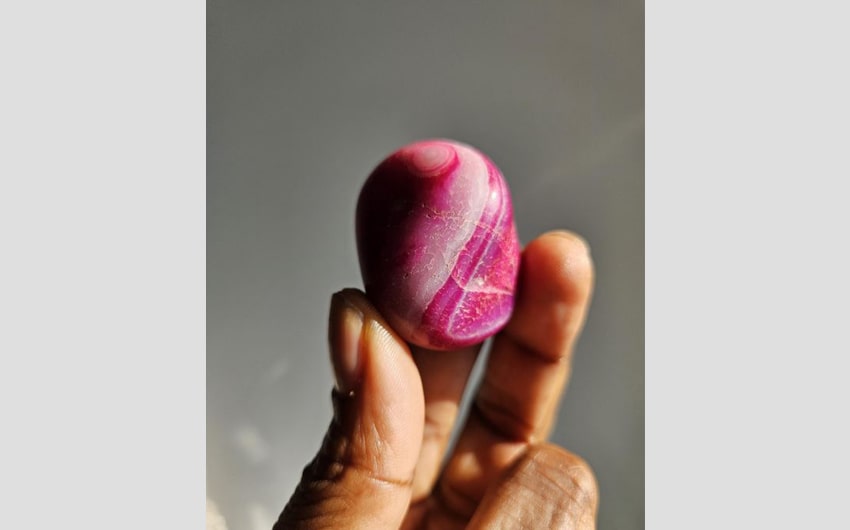
Image source: Pinterest
Types of Pink Agate
Pink agate comes in several varieties, each offering unique characteristics that make it special. The different types of pink agate are often distinguished by their color intensity, banding patterns, and whether they are natural or treated. Here are the most common types:
1. Natural Pink Agate
Natural pink agate is formed through natural geological processes, with no artificial enhancement to its color. These stones tend to have softer, more muted pink tones, often with light to medium banding patterns. The natural pink hues are subtle and calming, making these stones popular for those seeking a more earthy, understated aesthetic.
Natural pink agates often have a more opaque appearance, with swirling patterns and layers of white, gray, or pale pink. These stones are highly valued by collectors for their authenticity and natural beauty.
2. Dyed Pink Agate
Dyed pink agate is created by taking a natural agate stone and enhancing its color through a dyeing process. This technique allows for a wide range of bright pink shades, from soft baby pinks to intense magentas. The dyeing process enhances the stone’s natural banding patterns, making the layers more vibrant and pronounced.
While dyed pink agate may not be as naturally occurring as its untreated counterpart, it is incredibly popular in jewelry and decorative pieces because of its eye-catching colors. The vivid hues appeal to those looking for bolder statement pieces in their jewelry or home décor.
3. Banded Pink Agate
Banded pink agate is characterized by its prominent, defined layers of pink, white, and sometimes gray. The bands in these stones create striking patterns that add to their visual appeal. The banding can range from soft, wavy lines to bold, contrasting stripes, giving each stone its own distinct appearance.
Banded pink agate is often used in jewelry pieces like pendants, earrings, and bracelets, where the unique patterns can be highlighted. It is also a popular choice for home décor items such as coasters, bookends, and decorative slabs.
4. Pink Lace Agate
Pink lace agate is a variety of pink agate that is known for its intricate lace-like patterns and soft pink hues. The swirling, delicate patterns give the stone a graceful appearance, and it is often used in jewelry to add a touch of elegance. Pink lace agate is prized for its soothing energy, and it is often associated with emotional healing and nurturing.
This type of agate is often used in cabochon form for rings, pendants, and earrings, where the intricate patterns can be fully appreciated.
Physical Properties of Pink Agate
Pink agate, like other types of agate, has several unique physical properties that contribute to its beauty, durability, and versatility. These characteristics make it an ideal choice for jewelry, decorative items, and spiritual practices.
1. Color
The defining feature of pink agate is its beautiful color, which ranges from soft blush tones to deeper pinks. Natural pink agate tends to be more muted, with a gentle, earthy appearance, while dyed varieties offer more vibrant and saturated hues. The pink color is often interspersed with layers of white, gray, or even pale peach, giving each stone its own distinct look.
The color variations in pink agate are typically the result of trace elements present during the stone’s formation. For instance, iron and manganese can contribute to the pink tones seen in natural pink agate. The pink hues are often associated with love, compassion, and emotional balance in metaphysical practices, further enhancing the stone’s appeal.
2. Hardness and Durability
Pink agate ranks 6.5 to 7 on the Mohs hardness scale, making it a relatively durable stone for everyday use in jewelry. This level of hardness means that pink agate can withstand minor knocks and scratches, though it should still be treated with care to maintain its polish and integrity over time. Due to its durability, pink agate is often used in rings, pendants, bracelets, and earrings, as well as in larger decorative pieces such as sculptures and vases.
While pink agate is durable, it is still susceptible to damage from sharp blows or extreme temperature changes. It is important to handle the stone with care, particularly if it is part of a jewelry piece worn regularly.
3. Transparency and Luster
Pink agate typically exhibits a waxy or vitreous luster, giving it a smooth and polished appearance when cut and polished. The stone’s transparency ranges from opaque to slightly translucent, depending on the quality of the stone and the thickness of its layers.
In some cases, pink agate can exhibit a slight translucence at the edges, allowing light to pass through its thinner bands. This property makes pink agate particularly striking when used in backlit displays or when cut into thin slices for decorative purposes. The play of light through the layers adds to its visual appeal and enhances the intricate banding patterns within the stone.
4. Banding and Patterns
One of the most distinctive features of pink agate is its banding and layered patterns. These bands are formed over time as layers of minerals are deposited in rock cavities, creating unique swirls and lines within the stone. The banding in pink agate can vary greatly, from soft, wavy patterns to more pronounced, concentric rings.
The patterns within pink agate are highly sought after by collectors and jewelry makers, as no two stones are exactly alike. This uniqueness makes each piece of pink agate one-of-a-kind, adding to its value and desirability.
5. Uses in Jewelry and Décor
Due to its durability, vibrant color, and attractive patterns, pink agate is a popular choice for various forms of jewelry, including rings, necklaces, bracelets, and earrings. Its versatility makes it suitable for both casual and formal wear, and its affordability compared to other gemstones allows for a wide range of design possibilities.
Beyond jewelry, pink agate is also used in home décor, with items such as coasters, bookends, and ornamental slabs becoming popular. The stone’s natural beauty, combined with its metaphysical significance, makes it a favorite for those looking to bring both style and positive energy into their living spaces.
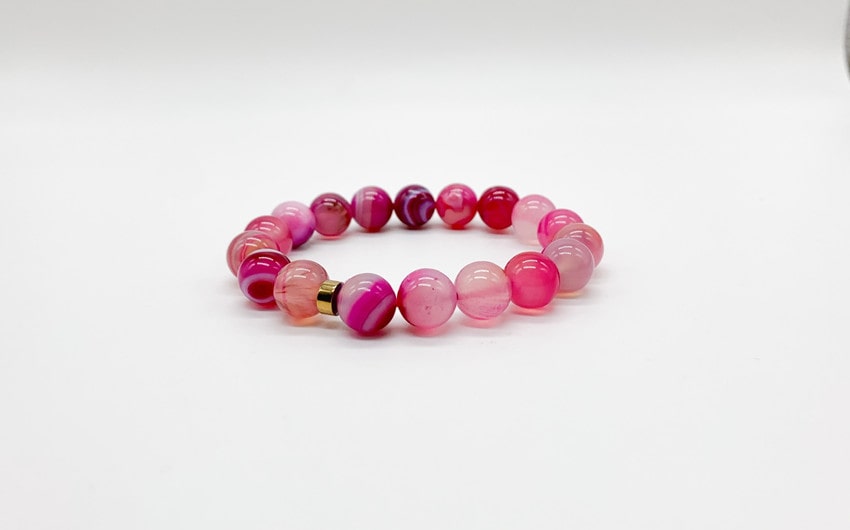
Healing and Metaphysical Properties of Pink Agate
Pink agate is not only admired for its aesthetic beauty but also cherished for its powerful healing and metaphysical properties. For centuries, agates have been used by different cultures for their ability to bring emotional balance, spiritual healing, and protection, and pink agate is no exception. The soft, soothing pink hues of this stone align it with love, compassion, and calming energies, making it a popular choice for those seeking emotional support and inner peace.
1. Emotional Healing and Balance
One of the primary benefits associated with pink agate is its ability to foster emotional healing and balance. Pink agate is believed to help those struggling with overwhelming emotions or stress by calming their minds and allowing them to process their feelings in a more balanced manner. It is especially known for soothing anxiety, reducing tension, and promoting emotional recovery after periods of heartache or trauma.
Pink agate is often recommended for people who are dealing with grief, loss, or relationship issues, as its nurturing energy is thought to help with emotional recovery and encourage a sense of peace. The stone is said to support self-love and acceptance, promoting inner strength and emotional resilience. It is frequently used by those who seek greater compassion for themselves and others.
2. Love and Compassion
Pink agate’s association with the heart chakra makes it a powerful stone for fostering love, kindness, and compassion. The heart chakra, located in the center of the chest, is responsible for feelings of love, connection, and empathy. When balanced, it allows one to give and receive love freely, without fear or insecurity. Pink agate is thought to open and balance the heart chakra, enhancing one’s capacity to love both themselves and others.
For those seeking to cultivate more compassion and understanding in their relationships, pink agate is said to help build emotional connections and promote harmony. It is also believed to strengthen romantic relationships, encouraging trust, emotional intimacy, and communication between partners.
3. Spiritual Growth and Grounding
Beyond its emotional benefits, pink agate is also considered a grounding stone. In the world of crystal healing, grounding stones are believed to help individuals connect with the earth’s energy and remain stable and centered in their daily lives. Pink agate is thought to help ground emotions and stabilize erratic energies, making it a useful tool for those who often feel overwhelmed or out of balance.
Pink agate is also used in spiritual practices for enhancing self-awareness and spiritual growth. It is believed to support introspection and meditation, helping individuals gain clarity on their life paths and purpose. Some people use pink agate to deepen their connection with higher consciousness and strengthen their intuitive abilities.
4. Protection and Strength
In addition to its emotional and spiritual properties, pink agate is often used as a protective stone. It is thought to create a protective shield around the user, warding off negative energy and harmful influences. This protective energy can help individuals feel more secure and confident in their surroundings, allowing them to approach challenges with greater strength and determination.
Popular Uses for Pink Agate
Thanks to its beauty and versatility, pink agate has a wide range of uses. Whether in jewelry, home décor, or personal collections, pink agate continues to be a favorite among those who appreciate its calming energy and aesthetic appeal.
1. Jewelry
Pink agate is widely used in jewelry due to its beautiful color and durability. It is a popular choice for rings, necklaces, earrings, and bracelets, where its soft pink hues can be showcased and appreciated. Pink agate jewelry is suitable for both casual and formal wear, as its natural elegance can complement a variety of outfits.
The stone’s emotional healing properties make it an ideal gift for loved ones, especially in the form of heart-shaped pendants or bracelets symbolizing love and compassion. Whether in a polished cabochon setting or as a raw, uncut stone, pink agate jewelry is timeless and versatile.
2. Home Décor
Pink agate has also become popular in home décor, adding a touch of natural beauty to interior spaces. Thin slices of pink agate are often used in coasters, bookends, and decorative wall art, where the stone’s banding patterns and colors can be displayed beautifully. Some larger pieces are used as tabletop accents, while smaller pink agate stones are often placed in decorative bowls or on altars for spiritual use.
Beyond aesthetics, pink agate is believed to bring a sense of peace and harmony into living spaces, making it a common choice for those who want to create a calming and positive atmosphere in their homes.
3. Crystal Healing and Meditation
In the world of crystal healing, pink agate is a favorite for meditation and energy work. Crystal healers use pink agate to balance emotional energy, open the heart chakra, and enhance compassion. The stone is often placed on the heart during meditation or worn as a pendant close to the chest to connect with its soothing energy.
Some practitioners also use pink agate in Reiki or other energy healing modalities, where the stone’s nurturing properties are thought to support emotional release and promote healing. Pink agate is also commonly included in crystal grids, where it helps to amplify loving and grounding energies.
4. Collecting
For those who appreciate the beauty of natural stones, pink agate is a popular addition to any crystal or gemstone collection. Each piece of pink agate is unique, with its own color variations, banding patterns, and textures, making it a prized collectible. Collectors often seek out rare or particularly beautiful specimens of pink agate, displaying them as decorative pieces or using them in their spiritual practices.
Caring for Pink Agate
Like all gemstones, pink agate requires proper care to maintain its beauty and energy. Although it is relatively durable, pink agate can still be susceptible to damage if not handled carefully. By following these simple steps, you can ensure that your pink agate remains vibrant and well-preserved.
1. Cleaning
Pink agate is best cleaned with warm, soapy water and a soft cloth or brush. Avoid using harsh chemicals or abrasive cleaners, as these can damage the surface of the stone or strip away its polish. After cleaning, be sure to rinse the stone thoroughly to remove any soap residue, and then dry it with a soft cloth.
It’s important to avoid exposing pink agate to extreme heat or direct sunlight for extended periods, as this can cause the color to fade, especially if the stone has been dyed. When cleaning dyed pink agate, use extra caution to ensure the color remains vibrant.
2. Storing
When not in use, pink agate should be stored in a soft pouch or jewelry box to protect it from scratches or damage. While pink agate is fairly hard, it can still be scratched or chipped if it comes into contact with other harder stones or metals.
If you have multiple pieces of jewelry or gemstones, it’s a good idea to store pink agate separately to prevent it from being scratched or damaged by other items in your collection.
3. Energizing and Cleansing
As with many crystals used in spiritual or metaphysical practices, pink agate can benefit from regular energy cleansing to maintain its energetic properties. There are several methods to cleanse pink agate’s energy, including:
- Smudging: Using sage, palo santo, or incense to clear away any negative or stagnant energy from the stone.
- Moonlight: Leaving pink agate under the light of the full moon to recharge its energy.
- Water Cleansing: Rinsing the stone under running water (use caution with dyed stones) to wash away any absorbed energy.
- Sound Cleansing: Using sound vibrations from a singing bowl or tuning fork to refresh the stone’s energy.
Regular cleansing can help maintain the metaphysical properties of pink agate and ensure that it continues to bring positive energy into your life.

